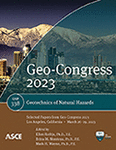FHWA NextScour Case Studies: Bridging Hydraulic Loads with Soil Erosion Resistance
Publication: Geo-Congress 2023
ABSTRACT
The Federal Highway Administration (FHWA) is developing NextScour, a scour research initiative to improve scour analysis and provide more accurate scour depth estimates for bridge foundation design. NextScour considers the two major components of scour: hydraulic loads and the erosional resistance of soils. Through an ongoing transportation pooled fund study, FHWA partnered with several state departments of transportation to provide soil and erosion testing services for bridge scour evaluations, which has resulted in several excellent case studies for the NextScour initiative. This paper summarizes the evaluations of two bridge replacement projects in Michigan (MI) and North Carolina (NC). The proposed bridge site in MI had a calculated scour depth that exceeded 11 m; however, a layer of medium-to-hard clay at depths of 4.6–6.1 m below the channel was identified in the geotechnical site investigation. The NC bridge site has a shallow medium to very stiff clay layer 1.2 m underneath the fine sand of the riverbed. As part of the subsurface exploration, samples of both clayey soils were collected and tested by FHWA to obtain the erosion resistance and other geotechnical properties. The resulting critical shear stress measurements suggested that both clay layers would be resistant to scour from the design floods, potentially saving costs on the foundation designs for both bridge replacements. This paper presents an overview of the NextScour initiative, discusses current and proposed methods to evaluate hydraulic loads and soil erosion resistance, details the two case studies, and provides a summary of the hydraulic and geotechnical testing conducted within the context of NextScour.
Get full access to this article
View all available purchase options and get full access to this chapter.
REFERENCES
Annandale, G. W. (2006). Scour Technology. Mechanics and Engineering Practice. McGraw-Hill.
Arneson, L., Zevenbergen, L., Lagasse, P., and Clopper, P. (2012). Hydraulic Engineering Circular No. 18, Evaluating Scour at Bridges, Fifth Edition. Washington, DC: Federal Highway Administration.
Briaud, J.-L., Chen, H., Li, Y., Nurtjahyo, P., and Wang, J. (2004). Pier and contraction scour in cohesive soils., Washington, DC.
Briaud, J.-L., Ting, F. C. K., Chen, H. C., Han, S. W., and Kwak, K. W. (2001). “Erosion function apparatus for scour rate predictions.” Journal of Geotechnical and Geoenvironmental Engineering, 127(2), 105–113.
Ettema, R., Nakato, T., and Muste, M. (2010). Estimation of Scour Depth at Bridge Abutments. NCHRP Project 24-20. Transportation Research Board, National Academy of Science, Washington, DC.
FHWA (Federal Highway Administration). (2022). FHWA Hydraulics Policy and Memos. https://www.fhwa.dot.gov/engineering/hydraulics/policymemos.cfm (June 7, 2022).
FHWA (Federal Highway Administration). (2020). “TPF-5(461) Soil and Erosion Testing Services for Bridge Scour Evaluations.” <https://www.pooledfund.org/Details/Study/688>(June 2, 2022).
Kalla, H. (2021). “Scour: A FHWA Perspective.” Keynote address, 10th International Conference on Scour and Erosion, ASCE, Virtual, October 17, 2021.
Shan, H., Pagenkopf, J., Kerenyi, K., and Huang, C. (2021a). “NextScour for improving bridge scour design in the United States.” Proceedings of the Institution of Civil Engineers - Forensic Engineering, 173(4), 121–129.
Shan, H., Pagenkopf, J., Kerenyi, K., and Huang, C. (2021b). “Hydraulic load decay functions for contraction and abutment scour calculation in fine-grained soils and erodible rocks.” Proceedings of the 10th International Conference on Scour and Erosion, Arlington, VA.
Shan, H., Pagenkopf, J., Li, C., Zhang, Z., Pastrich, D., Wiblishauser, O., Huang, C., and Kornel, K. (2022). “Improving Scour Estimates with NextScour for the Lafayette Avenue Bridge Replacement Project.” International Journal of Geoengineering Case Histories: in publication.
Shan, H., Wagner, A., Kerenyi, K., Guo, J., and Xie, Z. (2011). “An ex-situ scour testing device for erosion research of cohesive soils.” Proceedings of the 2011 Engineering Mechanics Institute conference. Boston, MA, 1020–1027.
Shan, H., Wiblishauser, O., Kerenyi, K., Shen, J., Meyer, T., Pastrich, D., Pagenkopf, J., and Tsou, N. (2018). “An in situ scour testing device for determining soil erosion resistance.” Proceedings of the 9th International Conference on Scour and Erosion, Taipei, Taiwan, 559–566.
Shan, H., Wiblishauser, O., Kerenyi, K., Uhrig, M., Huang, C., and Pagenkopf, J. (2021c). “Efficient automated laboratory testing of erosion resistance for fine-grained soils.” Proceedings of the 10th International Conference on Scour and Erosion, Arlington, VA, USA, 1063–1071.
USGS. (2022). “National Water Information System: Web Interface.” https://waterdata.usgs.gov/nwis/rt (June 7, 2022).
Information & Authors
Information
Published In
History
Published online: Mar 23, 2023
ASCE Technical Topics:
- Business management
- Case studies
- Clays
- Continuum mechanics
- Design (by type)
- Dynamic loads
- Dynamics (solid mechanics)
- Engineering fundamentals
- Engineering mechanics
- Erosion
- Federal government
- Foundation design
- Foundations
- Geology
- Geomechanics
- Geotechnical engineering
- Government
- Hydraulic engineering
- Hydraulic loads
- Hydraulics
- Load and resistance factor design
- Load factors
- Methodology (by type)
- Organizations
- Practice and Profession
- Research methods (by type)
- Scour
- Soil mechanics
- Soils (by type)
- Solid mechanics
- Structural design
- Structural dynamics
- Water and water resources
Authors
Metrics & Citations
Metrics
Citations
Download citation
If you have the appropriate software installed, you can download article citation data to the citation manager of your choice. Simply select your manager software from the list below and click Download.
